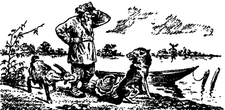Solving the River Crossing Puzzle with Go
Programming Snapshot – Go Game States

© Lead Image by am not, CC BY-SA 3.0, https://commons.wikimedia.org/w/index.php?curid=18656684
How does a ferryman transport a wolf, a goat, and a cabbage across a river in a boat that can only carry the ferryman plus one item at a time, without the wolf eating the goat or the goat eating the cabbage while left together back on shore? Mike programs the solution in Go.
Whether it is a wolf, a goat, and a cabbage, or one of the many variations on this scenario, keeping the participants safe during passage is part of the classic river crossing logic puzzle [1]. Humans find a solution to these brainteasers by trial and error. Computers, on the other hand, determine the solution by exploring trees of interlinked state sequences, eventually arriving at the desired final state by following one of many different available paths [2].
Before crossing the river, the ferryman, the wolf, the goat, and the cabbage are initially on the west bank. The ferryman can only take one of the three candidates into the boat and cross over to the east bank. During the crossing, he has to take care not to leave the wolf and goat alone on the bank, because the wolf would eat the goat. The same applies to the goat and the cabbage, as goats like to eat cabbage.
The riddle seems unsolvable at first. For example, once the ferryman has crossed the river with the goat and returns on an empty run, the only choice he has is between the wolf and the cabbage as the next candidate. However, neither will get along with the goat on the other bank. The trick is that the ferryman can also carry passengers on the return journey, thus ensuring that he never leaves a dangerous combination (goat/cabbage or wolf/goat) unattended.
[...]
Buy this article as PDF
(incl. VAT)
Buy Linux Magazine
Subscribe to our Linux Newsletters
Find Linux and Open Source Jobs
Subscribe to our ADMIN Newsletters
Support Our Work
Linux Magazine content is made possible with support from readers like you. Please consider contributing when you’ve found an article to be beneficial.

News
-
Parrot OS Switches to KDE Plasma Desktop
Yet another distro is making the move to the KDE Plasma desktop.
-
TUXEDO Announces Gemini 17
TUXEDO Computers has released the fourth generation of its Gemini laptop with plenty of updates.
-
Two New Distros Adopt Enlightenment
MX Moksha and AV Linux 25 join ranks with Bodhi Linux and embrace the Enlightenment desktop.
-
Solus Linux 4.8 Removes Python 2
Solus Linux 4.8 has been released with the latest Linux kernel, updated desktops, and a key removal.
-
Zorin OS 18 Hits over a Million Downloads
If you doubt Linux isn't gaining popularity, you only have to look at Zorin OS's download numbers.
-
TUXEDO Computers Scraps Snapdragon X1E-Based Laptop
Due to issues with a Snapdragon CPU, TUXEDO Computers has cancelled its plans to release a laptop based on this elite hardware.
-
Debian Unleashes Debian Libre Live
Debian Libre Live keeps your machine free of proprietary software.
-
Valve Announces Pending Release of Steam Machine
Shout it to the heavens: Steam Machine, powered by Linux, is set to arrive in 2026.
-
Happy Birthday, ADMIN Magazine!
ADMIN is celebrating its 15th anniversary with issue #90.
-
Another Linux Malware Discovered
Russian hackers use Hyper-V to hide malware within Linux virtual machines.

